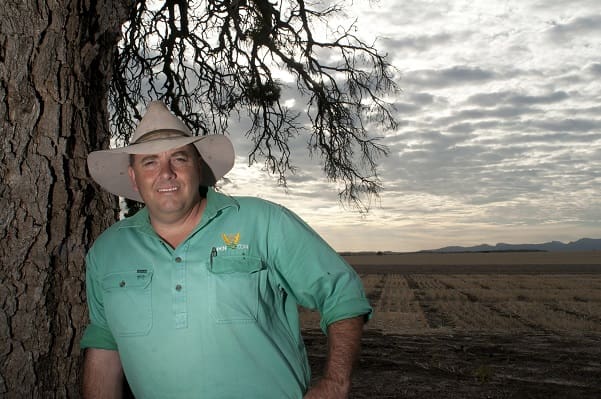THIS year’s residual herbicide applications may play a critical role in dictating 2019/2020 summer crop options for growers across the northern grains region with dry conditions continuing to plague large tracts of New South Wales and Queensland.
Without adequate moisture, residual herbicides take longer to break down within the soil which may pose a potential risk to the germination and vigour of successive crops.
The persistence of residual herbicides can be difficult to predict as it depends on numerous factors including soil temperature and moisture, microbial activity, soil type, soil pH, soil organic matter and the chemistry of the herbicide used.
However, there are some key points for growers to keep in mind over the coming months:
- Soil microbial activity is critical for herbicide breakdown and is significantly affected by lack of moisture. As a general rule of thumb, if the top 10cm of soil isn’t moist, then little herbicide degradation is occurring regardless of how many months have passed.
- Consider how rain has fallen since the herbicide application rather than simply calculating the rainfall total. A single rainfall event with months of dry topsoil is less effective at sustaining microbial populations compared to the same rainfall occurring as a number of events that keep the topsoil wet for longer.
- Consider the mobility of the herbicide. Those with higher water solubility and lower affinity for soil binding can move down the soil profile after rainfall events and sit below the zone of optimum microbial activity. This can increase persistence.
- Adhere to label recommendations on plant back period to minimise the risk of crop damage.
Access to latest information
Independent Consultants Australian Network (ICAN) senior consultant Mark Congreve, who has been co-ordinating workshops on herbicide behaviour, said keeping abreast of the latest information on pre-emergent chemistries could help guide rotation planning and paddock selection in response to changes in seasonal conditions.
“That’s certainly the case this season where growers may have applied pre-emergent herbicides expecting that adequate rain would fall during last summer and into this winter,” Mr Congreve said.
“In many areas, this simply hasn’t been the case which may trigger plant back implications for the upcoming summer crop.
“However, predicting herbicide persistence can be complex. When on the edge of the labelled plant back periods, understanding the soil type, the environmental conditions since application and the herbicide properties can give a higher level of confidence as to the likelihood of damaging residue levels remaining.”
Seasonal impact on soil microbial activity
Soil microbial activity is a major degradation pathway for most herbicides and happens relatively fast when the conditions are right to support microbial populations.
Conditions that favour microbial populations include oxygen, warm soil temperature, an adequate level of organic matter, soil pH and good soil moisture.
In these conditions, microbial populations are usually at their highest levels in the top 10 centimetres of soil and populations rapidly decline below 15cm where conditions are often less suitable to sustain microbial activity.
With moisture typically being the most limiting factor in microbial activity and therefore herbicide breakdown, Mr Congreve said it was imperative that growers assess the extent and duration of soil moisture rather than simply calculating total rainfall over the period since the herbicide application.
“It’s important to consider how rainfall occurred rather than just looking at the rainfall total – it’s better to think in terms of the number of weeks of moist topsoil,” he said.
“Most labels will have a plant back period specifying the number of months and a rainfall requirement.”
Herbicide mobility and persistence – be aware
Mobile herbicides, or herbicides with higher water solubility and lower affinity for soil binding, can move down through the soil profile after rainfall events. Where herbicide moves below the zone of optimum microbial activity it is likely to persist much longer.
Mobile herbicides can cause issues when there is a physical or chemical change in the subsoil, such as a pH change at depth or some other structural limitation such as a plough pan, significant soil structure changes or a sodic layer that causes the herbicide to concentrate at depth and prevents further leaching.
All Group B herbicides, such as sulfonylureas (SUs) and imidazolinone (IMIs), and the residual Group I herbicides, such as clopyralid (Lontrel) and picloram (Tordon), are highly mobile in soil water and subject to these issues.
The Group C triazine herbicides can also be subject to moving down the profile but typically aren’t as soluble as these other groups.
When estimating the length of a herbicide’s persistence, Mr Congreve advised considering the half-life of the herbicide, which is presented as the DT50, meaning the days of time for 50 per cent of the herbicide to dissipate.
“Residual herbicides with a short DT50, for example less than 20 days, will be lost relatively fast under normal conditions and are less likely to give significant plant back restrictions the following year. Herbicides with a longer DT50 value are likely to persist much longer,” he said.
Where to with planning?
A sustained break in the season would deliver growers the plant back certainty they need for the upcoming summer season. However, if the worst-case scenario plays out and marginal rainfall is received over the following three months, what is the advice for growers?
Agronomist and principal of PenAgCon at Bellata in north west NSW, Drew Penberthy, suggests being prepared for a variety of seasonal scenarios and planning ahead on crop choice and variety selection.
“With only around five percent of the winter crop area planted in the region this year due to the dry conditions, there hasn’t been as much residual herbicide applied as would normally be the case,” he said.
“Nevertheless, we’re still advising growers to be prepared for whatever the season delivers and adhere to label plant back recommendations to minimise the risk of seedling damage in cotton and sorghum crops.”
Source: GRDC
The GRDC is hosting Herbicide Behaviour workshops in the lead up to the summer cropping season at Moree on October 15-16, Toowoomba on October 17-18 and Gunnedah on October 31-November 1. For more information visit the GRDC events page https://grdc.com.au/events or to register visit https://www.icanrural.com.au/herbicideworkshops.html
Useful resources:
GRDC reference manual Soil Behaviour of Pre-Emergent Herbicides In Australian Farming Systems
GRDC pre-emergent herbicide videos on solubility and binding https://www.youtube.com/watch?v=s63GYYyflzw and incorporation by sowing https://www.youtube.com/watch?v=LJNjuMWS57U
https://www.diversityera.com/courses/pre-emergent-herbicides-101
Grain Central: Get our free daily cropping news straight to your inbox – Click here





HAVE YOUR SAY